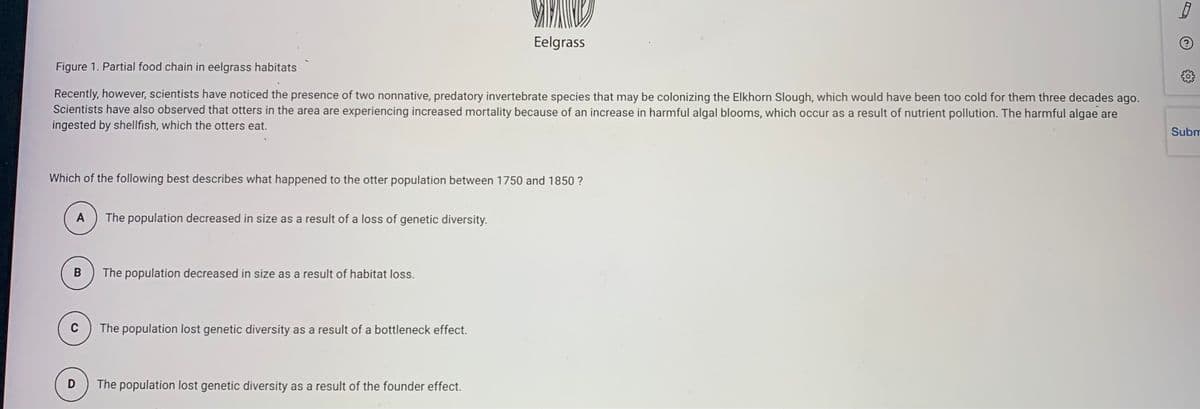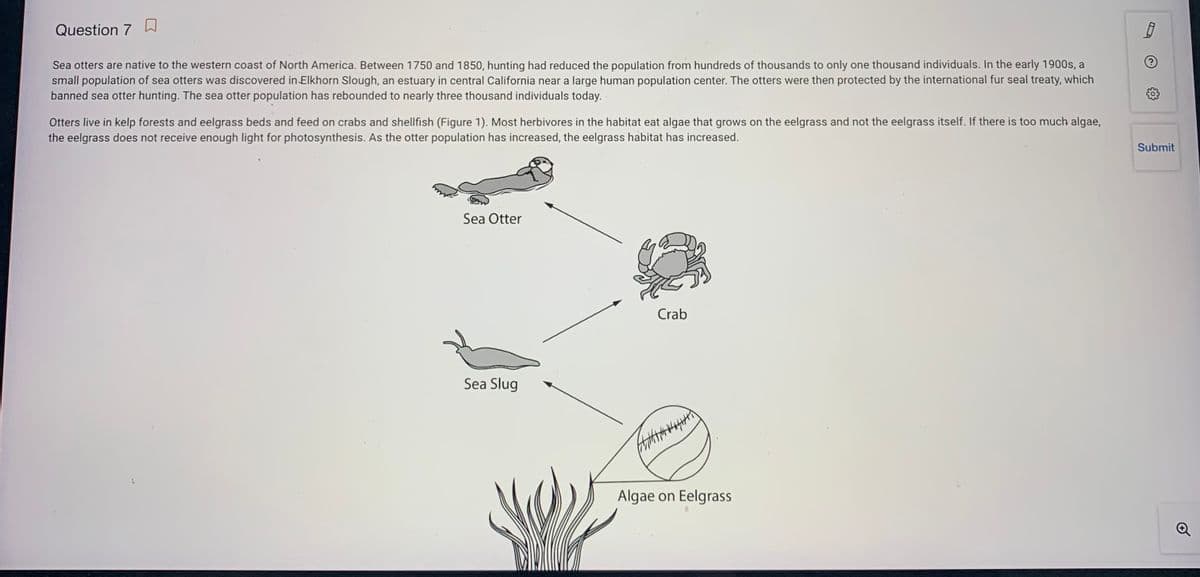Figure 1. Partial food chain in eelgrass habitats Recently, however, scientists have noticed the presence of two nonnative, predatory invertebrate species that may be colonizing the Elkhorn Slough, which would have been too cold for them three decades ago. Scientists have also observed that otters in the area are experiencing increased mortality because of an increase in harmful algal blooms, which occur as a result of nutrient pollution. The harmful algae are ingested by shellfish, which the otters eat.
Figure 1. Partial food chain in eelgrass habitats Recently, however, scientists have noticed the presence of two nonnative, predatory invertebrate species that may be colonizing the Elkhorn Slough, which would have been too cold for them three decades ago. Scientists have also observed that otters in the area are experiencing increased mortality because of an increase in harmful algal blooms, which occur as a result of nutrient pollution. The harmful algae are ingested by shellfish, which the otters eat.
Human Anatomy & Physiology (11th Edition)
11th Edition
ISBN:9780134580999
Author:Elaine N. Marieb, Katja N. Hoehn
Publisher:Elaine N. Marieb, Katja N. Hoehn
Chapter1: The Human Body: An Orientation
Section: Chapter Questions
Problem 1RQ: The correct sequence of levels forming the structural hierarchy is A. (a) organ, organ system,...
Related questions
Question

Transcribed Image Text:Eelgrass
Figure 1. Partial food chain in eelgrass habitats
Recently, however, scientists have noticed the presence of two nonnative, predatory invertebrate species that may be colonizing the Elkhorn Slough, which would have been too cold for them three decades ago.
Scientists have also observed that otters in the area are experiencing increased mortality because of an increase in harmful algal blooms, which occur as a result of nutrient pollution. The harmful algae are
ingested by shellfish, which the otters eat.
Subm
Which of the following best describes what happened to the otter population between 1750 and 1850 ?
A
The population decreased in size as a result of a loss of genetic diversity.
The population decreased in size as a result of habitat loss.
C
The population lost genetic diversity as a result of a bottleneck effect.
D
The population lost genetic diversity as a result of the founder effect.

Transcribed Image Text:Question 7 W
Sea otters are native to the western coast of North America. Between 1750 and 1850, hunting had reduced the population from hundreds of thousands to only one thousand individuals. In the early 1900s, a
small population of sea otters was discovered in Elkhorn Slough, an estuary in central California near a large human population center. The otters were then protected by the international fur seal treaty, which
banned sea otter hunting. The sea otter population has rebounded to nearly three thousand individuals today.
Otters live in kelp forests and eelgrass beds and feed on crabs and shellfish (Figure 1). Most herbivores in the habitat eat algae that grows on the eelgrass and not the eelgrass itself. If there is too much algae,
the eelgrass does not receive enough light for photosynthesis. As the otter population has increased, the eelgrass habitat has increased.
Submit
Sea Otter
Crab
Sea Slug
Algae on Eelgrass
Q
Expert Solution
This question has been solved!
Explore an expertly crafted, step-by-step solution for a thorough understanding of key concepts.
This is a popular solution!
Trending now
This is a popular solution!
Step by step
Solved in 3 steps

Knowledge Booster
Learn more about
Need a deep-dive on the concept behind this application? Look no further. Learn more about this topic, biology and related others by exploring similar questions and additional content below.Recommended textbooks for you

Human Anatomy & Physiology (11th Edition)
Biology
ISBN:
9780134580999
Author:
Elaine N. Marieb, Katja N. Hoehn
Publisher:
PEARSON

Biology 2e
Biology
ISBN:
9781947172517
Author:
Matthew Douglas, Jung Choi, Mary Ann Clark
Publisher:
OpenStax

Anatomy & Physiology
Biology
ISBN:
9781259398629
Author:
McKinley, Michael P., O'loughlin, Valerie Dean, Bidle, Theresa Stouter
Publisher:
Mcgraw Hill Education,

Human Anatomy & Physiology (11th Edition)
Biology
ISBN:
9780134580999
Author:
Elaine N. Marieb, Katja N. Hoehn
Publisher:
PEARSON

Biology 2e
Biology
ISBN:
9781947172517
Author:
Matthew Douglas, Jung Choi, Mary Ann Clark
Publisher:
OpenStax

Anatomy & Physiology
Biology
ISBN:
9781259398629
Author:
McKinley, Michael P., O'loughlin, Valerie Dean, Bidle, Theresa Stouter
Publisher:
Mcgraw Hill Education,

Molecular Biology of the Cell (Sixth Edition)
Biology
ISBN:
9780815344322
Author:
Bruce Alberts, Alexander D. Johnson, Julian Lewis, David Morgan, Martin Raff, Keith Roberts, Peter Walter
Publisher:
W. W. Norton & Company

Laboratory Manual For Human Anatomy & Physiology
Biology
ISBN:
9781260159363
Author:
Martin, Terry R., Prentice-craver, Cynthia
Publisher:
McGraw-Hill Publishing Co.

Inquiry Into Life (16th Edition)
Biology
ISBN:
9781260231700
Author:
Sylvia S. Mader, Michael Windelspecht
Publisher:
McGraw Hill Education